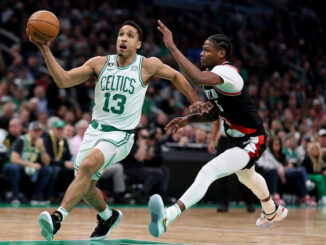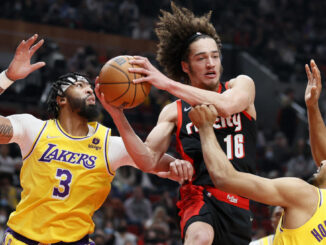
Building a successful basketball team, no matter your definition of “successful,” can be a tricky business. It takes all kinds of intelligent, talented people to make it work on the business side, in advertising and marketing, from the ownership team (whether they’re a group of people or anchored by one man), as well as on the basketball side, the part of a National Basketball Association franchise we often see the most. Its public face, if you will.
The Portland Trail Blazers have been a very successful business through most of its near-50-year history. There have been rough patches, mostly on the rare occasions the basketball team has been non-competitive, but by-and-large they enjoy the kind of attendance records and fan devotion rarely seen in North American professional sport; only the NFL’s Green Bay Packers, the NBA’s Utah Jazz, and baseball’s Chicago Cubs can claim similarly consistent and long-lived streaks of sellouts in their histories.
What I mean to say is, the Blazers have a very devoted fan base that cares deeply for the team. And I happen to be a part of that fan base, even though I try to create as much of an air of detachment as I can. Even after four years of writing for this website, with three years of off-and-on contributing before coming to OSN, I still have the raw instincts of a fan. I still get attached.
Which is why it’s a little painful for me to suggest trades, or condemn a player’s performance, or admit that Player X is better than Blazer Y in their roles for their separate teams. Such juvenile comparing is a favored pastime of men, though we now do it through cars and who makes the most money instead of through spears and who killed the biggest mammoth today. Of course, one thing that will always stand the test of time is the “I’ll show you mine if you show me yours” thing boys do. But enough about that.
Ever since the Blazers were eliminated in brutal fashion by the New Orleans Pelicans, I’ve been pondering many things about this team. Two subjects of interest are Damian Lillard and CJ McCollum, the stars of the current era in Rip City. Their place in Trail Blazer history, their standing in the NBA, Lillard’s chances of becoming the best Blazer of all time, Dame’s potential Hall of Fame credentials (yes, he could get there), whether McCollum could put up Lillard-like numbers if he were the Man elsewhere, and whether they can win a championship together, among other things.
Both guys still have many years of playing in front of them, but we can safely say the early days for them are over, and they’re hitting their peak years; Lillard is already there. They’re under contract for most of their primes, as well. Whether we continue to see them work together is a question that has been raised before, and might take months, years, or a Paul Allen whim to answer.
Damian Lillard Career Stats
| MPG | PPG | FG% | 3PT% | FT% | RPG | APG | 3PTFGS | POINTS | PER |
| 36.4 | 23.1 | 43% | 37% | 88% | 4.1 | 6.2 | 1269 | 10,842 | 21 |
Whenever someone talks about Lillard, the first thing they touch upon is the outside shooting. Lillard is not an especially accurate three-point shooter (his career percentage is above league-average, but behind most of his peers), but he gets them in volume. Enabled by Terry Stotts’ offense, the eternal green light, and shooting range that easily goes out to 30 feet, Lillard can make the steady fall of threes through the hoop resemble the steady fall of rain during the fall and winter in Portland (and mostly in spring, too).
Lillard is the only Trail Blazer to make 1,000 three-pointers for the team, as well as 47th all-time in made threes in NBA history. During his peak, post-LaMarcus Aldridge years, Lillard has made over 200 threes a season, so if we assume he hits 231 threes for an even 1500, he’d pass guys like Terry Porter (who already lost his Blazer-specific spot to Lillard), Allan Houston, Mitch Richmond, Mike Dunleavy, Dan Majerle (we’re going down memory lane here, guys), Michael Finley, Brent Barry, Antoine Walker, and Carmelo Anthony (do you see Melo making 100 threes again in his career?). The year after that, he’d pass up almost all the old-school shooters and get into the top 20 all-time.
As of 2018, no player has made 3,000 career threes; Ray Allen came oh so close with 2,973. (Maybe that’s why Allen took so long to officially retire? Why couldn’t some crap-ass team give him the chance to make 3,000?) By 2038, we could have a top 25 full of 3,000 three-pointer totals, with Stephen Curry, James Harden, Klay Thompson, and our man Dame right at the top of the list. 3,000 threes is one keystone that Lillard would have to hit to have a Hall of Fame case.
(A few quick tangents about the NBA three-point list: there are only eight men right now that have over 2,000 made threes: Allen, Reggie Miller, Jason Terry [active], Kyle Korver [active], Jamal Crawford [I guess he’s active?], Paul Pierce, Stephen Curry [alien], and Vince Carter [immortal]. Curry is incredible. Also, Dirk Nowitzki has 1,918 threes, and might join that list before he retires. J.R. Smith, idiot extraordinaire, has 1,917 threes, and will likely go over 2,000 next season. We are about to live in a world where the Living Meme J.R. Smith has more made threes in his career than the great Dirk Nowitzki. I’m not ready.)
Lillard has also developed his game to be reasonably well-rounded on offense. He consistently hits his centers when they roll to the rim, can make the extra pass to open shooters, and helps corral long rebounds. A 27-5-7 stat line for the next three years wouldn’t be out of the question, and would be the kind of production a No. 1 or 2 option has on a contending team.
Lillard’s position in the NBA is as the best player on a playoff team, yet he could be the best or second-best guy on a contender if the team was built well. Portland, unfortunately, has not been well-run since Aldridge left, with outsized contracts doled out by Neil Olshey, a Los Angeles guy who felt that he had to pay above-market prices for talent to compensate for Portland’s location, rather than emphasizing that said talent gets to play with Damian Freaking Lillard, and will always have open shots, and Lillard will always find them.
With a big-city slicker like Olshey running the team, and with the 2016 contracts continuing to gum up the Blazers’ cap space like a big ball of hair clogging the bathroom sink, it seems unlikely that Lillard will get his wish of bringing a second NBA championship to Stumptown. The question before Lillard, then, is this: what matters more to him, becoming the best Portland Trail Blazer ever, or chasing a championship while he’s young enough to make a difference?
Last season, Lillard expressed his frustration to Paul Allen about the team’s direction, and getting crushed by the Pelicans likely added to his discontent. The Blazers made no big moves during the Draft, selecting Anfernee Simons at No. 24, a raw kid that was likely drafted so Olshey can stash him in the G-League and avoid paying his guaranteed first-round salary this season, adding to the Blazers’ luxury tax payment. Re-signing Jusuf Nurkic to a solid four-year, $48 million contract was a good deal (the Blazers were going into the tax even if Nurk signed the one-year, cheaper qualifying offer), but it does nothing but bring last year’s team back for one more go, the same team that Anthony Davis sliced through like a scythe through wheat. Given the situation, some national columnists have included Lillard in the hundreds of “superstar player in non-competitive situation trade speculation” articles those guys write on a weekly basis nowadays. There are rumors swirling this offseason about a potential Lillard trade.
On the other hand, Lillard likes Portland. The city and its fans have embraced him, and between this place and the fact he spent his college years in Utah, Lillard has no real desire or instinctual need to go to a big city, or a warm-weather area. He signed a nine-figure Adidas shoe deal and released multiple rap albums in Portland, the land of hipsters, beer, and weird facial hair; why the hell does he need to go to Los Angeles to do all the things he wants to do?
I’d say Lillard is already in the top three among Blazers all time. Brandon Roy didn’t play long enough, and Lillard’s production and durability trumps Roy’s borderline-top 10 player performances of a decade ago. Aldridge is the career Blazer leader in total and defensive rebounding, and is in the top 10 in many other categories, but he had no real playoff success before Lillard came to Portland, and Lillard is looking to do something in six and a half seasons what Aldridge did in nine, score 12,000 points in a Blazer uniform.
Also, Rasheed Wallace was the best player on consecutive Western Conference Finals teams for Portland, but he was an overly emotional and immature man who couldn’t handle the stress of being pegged as the top guy on a contending team. Sheed was content to be a supporting player on a boring and brutal Detroit team that won a title and made another Finals, and likely would have killed basketball as a profitable business if it weren’t for the LeBron Generation. His time in Portland could be summed up like this: when the team retired the number 30, they honored Terry Porter, the starting point guard on the two Finals teams in the 1990s, and Bobby Gross, the starting small forward on the 1977 championship team. Thing is, Wallace also wore #30, yet the Blazers chose to pay no mind, homage, or heed to Sheed’s accomplishments while in Portland, despite the fact he was the best player out of the three. He was that toxic to the community, but that gets lost in all the memes and chats with Kevin Garnett in the TNT studios.
There are only two Blazers I’d put above Lillard in the all-time hierarchy. First would be Bill Walton, the basketball immortal who was the best player on the 1977 championship team, the only Blazer to ever win the Most Valuable Player award (he won in 1978), and is considered one of the 50 greatest players ever despite losing a great deal of his career to foot problems. Second on my list is Clyde Drexler, a super-athletic, stat-stuffing dunk machine that led the Blazers to their most successful sustained run in franchise history in the early-1990s, with two NBA Finals appearances in ’90 and ‘92 and a team-record 63-win season sandwiched between them in ’91. Drexler is also one of only three players in NBA history to record at least 22,000 points, 6,000 rebounds, and 6,000 assists in his career. The other two would be LeBron James and Kobe Bryant.
Lillard joined Walton and Drexler as the only Blazers to finish in the top five of MVP voting in 2018 (the Glide was runner-up to Michael Jordan in 1992, in more ways than one [insert sad emoji face]), and if health permits, he may be on the cusp of eclipsing Clyde’s Blazer scoring record, Terry Porter’s total assists record, and Kiki Vandeweghe’s points per game mark (Kiki is at 23.5, so Lillard could do it this next season) by the time his contract is done.
So, if Lillard doesn’t demand a trade before his deal runs out, he could be in position to make a massive decision, one that will shape his legacy and his professional life: to chase a championship by serving as a subordinate piece on The Next Big Superteam, or stay in Portland and become THE iconic Portland Trail Blazer?
CJ McCollum Stats, Nov. 2015-April 2018
| MPG | PPG | FG% | 3PT% | FT% | RPG | APG | 3PTFGS | POINTS | PER |
| 35.2 | 21.7 | 46% | 43% | 86% | 3.6 | 3.7 | 571 | 5,235 | 17.2 |
Whenever I watch CJ McCollum play, I’m reminded somewhat of Indiana Pacers great and Hall of Famer Reggie Miller. He is pretty much a shorter Reggie out there, except with much better handles and worse defense (not that Miller was a good defender, but being 6-7 is usually better than being 6-3 on a basketball court). CJ doesn’t get as many screens set for him as Reggie did, but he still navigates the geometry of the floor within the offense; all those off-ball actions, that running around, is like what the Miller-era Pacers did.
The goal of all that movement was to spring Miller for a three-point shot. Although Miller’s stats during his mid-late 90s peak evened out to a line of 21-3-3 with 42% three-point shooting, four things about Miller made him stand out, and eventually earned him a spot in Springfield: he had a very, very long career that let him amass 25,000 points, he was the best free-throw shooter of his time, he built a (somewhat inflated) reputation as a stone-cold clutch assassin (sensationalized by the New York media, which hated Reggie’s guts), and his reliance on the three-pointer as a principal weapon, the method of choice for scoring. Over half of his 25K points were from threes or free throws; the man was a clunky prototype of James Harden, the Model T to the Beard’s modern sports car.
Dale Ellis was likely the first true great three-point shooter, while Larry Bird was the first superstar player to incorporate the three-ball into his arsenal, but Reggie Miller was the first volume scorer that shot tons of threes. Reggie was launching from deep before Steph Curry made it cool.
Why do I highlight Reggie Miller? McCollum has a chance to become a better Reggie Miller, in terms of sheer counting stats. Will McCollum play 18 seasons, like Reggie? I doubt it; CJ is frail, and has plenty of interests outside of basketball. Doing this till he’s 40 doesn’t sound like something McCollum would do. There are other factors that stand in the way of maximizing McCollum’s potential, as well.
The problems with McCollum, and for the Blazers as a team, are his size and lack of ability to be a true point guard. He is somewhere between being a millionaire’s Lou Williams and a hobo’s James Harden, and for the Blazers, he trends towards being a very expensive knockoff of the 2018 MVP. He’s too good to be on the bench at this stage of his career, but he’s also not good enough to build an NBA champion team around. Like Reggie Miller.
In terms of being able to contend for a ring, McCollum’s ideal situation would be as the nominal point guard on a team with a ball-dominant wing, where he’s easily the smallest guy on the floor and can be helped out on defense, while he does what’s he’s always done in Portland: shoot threes at an elite clip, be very accurate from the free-throw line, break down the defense on secondary actions, and be a release valve when the shot clock is running down. He can absolutely be a valuable playoff piece for a contending team; CJ’s playoff averages are equal to or above his regular season totals. I hear there’s a team in Los Angeles that just signed a superstar, ball-dominant forward that loves having shooters and secondary ball handlers around him….
On the Blazers, this is pretty much McCollum’s ceiling. That’s why when folks talk about how the Blazers can improve, they tend to mention a trade involving McCollum. Lillard or McCollum can be a part of a title team someday…if they’re not on the same team, and especially if they’re not the two best players on that team.
So, I suppose that’s the ceiling of this current team, first-round fodder that can make the second round on a lucky year. On a certain level, that’s totally fine; not everyone can be a contender, and with all the player movement and teaming up by the league’s top talent, merely being a competitive squad is enough. It really doesn’t hurt the attendance numbers in Rip City, and the two guys at the top of the Blazers now are two of the best to ever play for our beloved team.
Lillard and McCollum might want to be more than that, though. And that might well be the reason, in a few years’ time, they might leave the trees and mountains behind in search of greener, golden pastures.
Thanks to basketball-reference.com for stats and research material.




